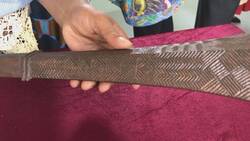Further Media


Producer unknown to us
Oceania, Polynesia, Tonga Archipelago (Tongatapu, 'Eua, Nomuka or Lifuka/Ha'apai group)
Before 1781
Wood – probably club tree (Casuarina equisetifolia)
Acquired in 1773–74 or 1777 on Captain James Cook’s second or third expedition in the Pacific. It is yet unknown by whom the object was acquired.
Brought from Great Britain to Germany by Benjamin La Trobe, a Moravian working in London.
Inv. no. 68651
This war club with ribbon-shaped moldings is carved from the wood of the cassowary tree, or club-tree, a craft that, like all woodwork in the Tongan archipelago, was the exclusive domain of men (tufunga). War clubs like these were the most important weapon on all the islands of Western and Eastern Polynesia and had a high status value.
In general, the design of the war clubs has a wide variety of shapes. In many Tongan variants – as in this one – the round handle widens in the last third into a diamond-shaped hitting surface. The carving consists of four sections of curved transverse bands on the hitting part of the war club, with three fields of notched carving in between. These were not meant to decorate or reinforce the striking part, but had a high spiritual and genealogical significance, indicating the owner and his rank within the aristocracy in the strictly hierarchical order of Indigenous Tongan society.
In battle and on ceremonial occasions, the abstract carving served as the “god of war”, [i.e.,] the mobilization of mana, the divine energy of the ancestors. Their presence was evoked by sacred red feathers attached to the end of the war club's handle by means of a coconut string in the grooves. Because of their high spiritual value, war clubs were wrapped in ngatu – precious Tongan bark bast cloth – in the seclusion of the Tongan home, which was considered a protective medium of mana.